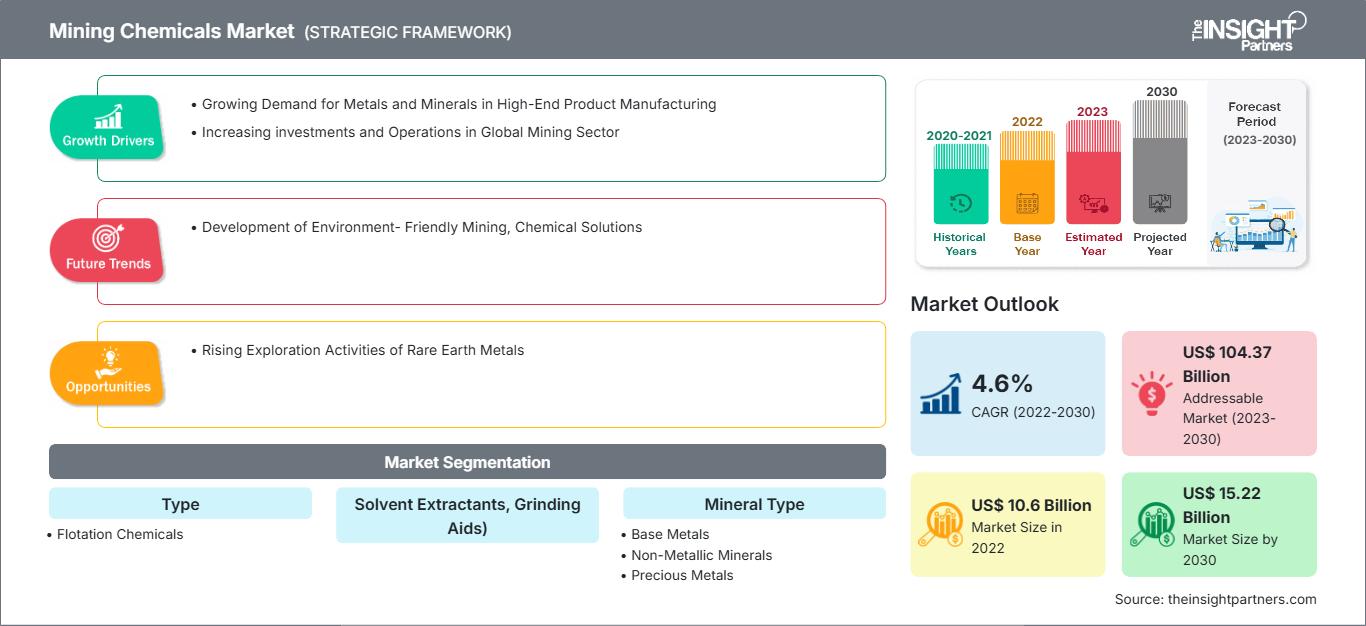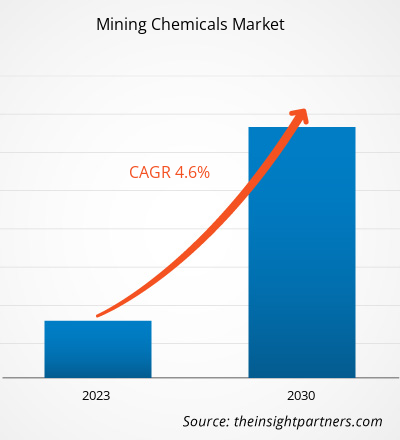[연구 보고서] 시장 규모는 2022년 106억 달러에서 2030년 152억 2천만 달러로 성장할 것으로 예상되며, 2022년부터 2030년까지 연평균 성장률 4.6%를 기록할 것으로 예상됩니다.
시장 통찰력 및 분석가 의견:
채광 화학물질은 광물 처리, 폐수 처리 등의 분야에 사용됩니다. 광물 및 광석의 종류에 따라 다양한 화학물질이 채광 공정에 사용됩니다. 채광 화학물질은 광석에서 원하는 광물 입자를 분리하는 화학 공정에 사용됩니다. 또한 저농도 광물을 순수 금속으로 정제하는 데에도 사용됩니다. 다양한 채광 화학물질에는 거품제, 응집제, 진정제, 포집제 등과 같은 부유 화학물질, 용매 추출제, 분쇄 보조제, 분진 제어 또는 억제 화학물질이 포함됩니다. 광업에서 사용되는 분진 제어 또는 억제 화학물질로는 염화칼슘, 염화마그네슘, 리그닌 설포네이트, 아스팔트 에멀젼, 오일 에멀젼, 고분자 에멀젼 등이 있습니다. 광업 화학물질의 다양한 이점, 광업의 강력한 성장, 그리고 다양한 금속 및 광물에 대한 수요 증가는 광업 화학물질 시장의 성장을 촉진합니다.
성장 동력 및 과제:
고급 제품 제조 분야에서 금속 및 광물에 대한 수요 급증은 세계 광업 화학물질 시장의 성장을 견인합니다. 자동차, 항공우주 및 전자 산업의 발전은 고급 제품 제조에 필요한 금속, 희토류 원소 및 광물에 대한 수요를 견인합니다. 금속 수요 증가는 필요한 원자재를 채굴하고 생산하기 위한 채굴 활동 증가로 이어지고, 궁극적으로 광상 접근, 불순물 제거, 암석 파쇄를 위해 광업 화학물질의 광범위한 사용으로 이어집니다. 또한, 금속 수요 증가에 따라 광업 회사들은 안전 조치 및 운영 효율성 향상에 더욱 주력하고 있습니다. 여기에는 발파 작업을 최적화할 수 있는 광산 폭발물 기술과 제형 개발이 포함됩니다. 금이나 백금과 같은 귀금속은 전기 및 전자 산업에서 전도성과 같은 특성 때문에 수요가 높습니다. 자동차 산업에서는 알루미늄, 티타늄, 고강도 강철과 같은 경량 금속을 사용하여 스포츠카 및 기타 고급 차량을 제조합니다. 내연 기관 및 전기 자동차용 경량 소재 생산 증가로 인해 지난 몇 년 동안 알루미늄 수요가 크게 증가했습니다. 유해 광산 화학물질과 관련된 엄격한 정부 규제는 광산 화학물질 시장 성장을 저해합니다. 광산 산업은 국가, 지역 및 지방 정부의 복잡한 규제 체계 속에서 운영됩니다. 각 관할 구역에는 광산 운영, 안전 기준, 환경 보호 및 지역 사회 참여와 관련된 자체 법률, 규정 및 지침이 있을 수 있습니다. 이러한 규제 요건을 충족하는 것은 광산 기업에게 시간과 자원이 많이 소요될 수 있습니다. 또한, 많은 국가에서 광산 운영 허가를 받는 것은 길고 복잡한 절차가 될 수 있습니다. 광산 회사는 포괄적인 신청서를 제출하고, 환경영향평가를 실시하고, 필요한 허가를 받기 위한 특정 기준을 충족해야 합니다. 여러 국가에서는 인체 건강과 환경에 미치는 악영향을 완화하기 위해 시안화물과 황산과 같은 일부 유해 화학물질의 광산 작업 사용을 금지했습니다.
요구 사항에 맞게 이 보고서를 사용자 정의하십시오.
이 보고서의 일부, 국가 수준 분석, Excel 데이터 팩을 포함하여 모든 보고서에 대한 사용자 정의를 무료로 받을 수 있을 뿐만 아니라 스타트업 및 대학을 위한 훌륭한 제안 및 할인을 이용할 수 있습니다
광산 화학 시장: 전략적 통찰력

-
이 보고서의 주요 주요 시장 동향을 확인하세요.이 무료 샘플에는 시장 동향부터 추정 및 예측에 이르기까지 데이터 분석이 포함됩니다.
보고서 세분화 및 범위:
"글로벌 광산 화학 물질 시장"은 유형, 광물 유형, 응용 분야 및 지역을 기준으로 세분화됩니다. 유형별로 시장은 부유 화학 물질, 용매 추출제, 분쇄 보조제 등으로 세분화됩니다. 부유 화학 물질 부문 시장은 거품제, 응집제, 억제제, 포집제 등으로 세분화됩니다. 광물 유형별로는 비금속, 비금속 광물, 귀금속 등으로 세분화됩니다. 응용 분야별로는 광물 처리, 폐수 처리 등으로 세분화됩니다. 지리적으로 시장은 북미(미국, 캐나다, 멕시코), 유럽(독일, 프랑스, 이탈리아, 영국, 러시아, 기타 유럽), 아시아 태평양(호주, 중국, 일본, 인도, 한국, 기타 아시아 태평양), 중동 및 아프리카(남아프리카, 사우디아라비아, UAE, 기타 중동 및 아프리카), 남미 및 중미(브라질, 아르헨티나, 기타 남미 및 중미)로 세분화됩니다.
세분화 분석:
유형에 따라 광산 화학 물질 시장은 부유 화학 물질, 용매 추출제, 분쇄 보조제 및 기타로 세분화됩니다. 부유 화학 물질 부문은 2022년에 가장 큰 시장 점유율을 기록했으며, 이 부문의 시장은 2022년부터 2030년까지 크게 성장할 것으로 예상됩니다. 부유 화학 물질은 광물 거품 부유 공정에서 광물의 부유성을 조정하는 데 사용되는 광산 화학 물질입니다. 다양한 광물 간의 습윤성 차이를 증가시켜 맥석 광물과 유용 광물을 분리할 수 있습니다. 대부분의 광물은 친수성입니다. 따라서 광물 분리를 위해서는 광석의 부유 거동을 인위적으로 조절해야 합니다. 선광기는 부유 시약을 첨가하여 특정 광물의 친수성 또는 소수성을 선택적으로 증가시킬 수 있습니다. 또한, 분쇄 보조제 또한 시중에서 주요 품목 중 하나입니다. 분쇄 보조제는 분쇄기에 투입하면 분쇄 효율을 높이고 전력 소비를 줄이는 물질입니다. 분쇄 보조제는 분쇄 과정 전체에서 광석의 응집력과 부착력을 줄여 처리량을 증가시키고 생산 병목 현상을 해소하는 데 도움이 됩니다. 고품위 광상이 고갈됨에 따라 광산 회사들은 저품질 광석을 채굴하고 있습니다. 이러한 광체에 접근하는 것은 종종 복잡하고 어려운 과정입니다. 따라서 광석의 가장 귀중한 원소를 가공하고 추출하기 위해서는 첨단 화학 기술과 더 많은 에너지가 필요합니다.
지역 분석:
광업 화학 물질 시장은 지리적 분포에 따라 북미, 유럽, 아시아 태평양, 중남미, 중동 및 아프리카의 5개 주요 지역으로 구분됩니다. 아시아 태평양 지역은 세계 시장을 주도했으며, 2022년에는 약 60억 1천만 달러의 시장 규모를 기록했습니다. 아시아 태평양 지역에는 미쓰비시 머티리얼즈(Mitsubishi Materials Corporation), 장시 구리(Jiangxi Copper Co Ltd), 중국 알루미늄(Aluminum Corporation of China Ltd), 인도 석탄(Coal India Limited), 중국 몰리브덴(China Molybdenum Co Ltd), BHP 등 주요 광산 기업들이 자리 잡고 있습니다. 이 지역에는 10개의 주요 노천 채굴 프로젝트가 있습니다.Green 광산(중국), Sangatta 광산(인도네시아), Heidaigou 광산(중국), Oyu Tolgoi 구리-금 광산(몽골), Gevra OC 광산(인도), Letpadaung 구리 광산(미얀마), Li 광산(태국), FTB 프로젝트(태국), Pasir 광산(인도네시아). 미국 지질조사국이 2022년에 발표한 보고서에 따르면, 중국은 2021년에 여러 국가에 25가지 비연료 광물을 가장 많이 공급한 국가였습니다. 또한, 중국은 25가지 나열된 광물 중 16가지 필수 광물을 생산합니다. 광산 화학 물질에 대한 수요는 이 지역의 광산 작업 및 광물 탐사 활동에 정비례합니다. 따라서 광산 작업의 성장은 아시아 태평양 지역의 광산 화학 물질에 대한 수요를 촉진합니다. 중동 및 아프리카는 글로벌 시장 점유율의 13% 이상을 차지하는 또 다른 주요 기여 지역입니다. 중동 및 아프리카 지역에서 광물, 금속, 비금속의 채굴 생산율이 증가함에 따라 해당 지역 전체에서 채굴용 화학물질에 대한 수요가 증가하고 있습니다. 남아프리카공화국 광물위원회(Mineral Council South Africa)가 2022년에 발표한 보고서에 따르면 남아프리카공화국의 광업 생산 가치는 2021년 570억 달러에서 2022년 610억 달러로 증가했습니다. 남아프리카공화국에서 철광석으로 발생한 총 매출은 2022년 54억 달러로 2019년 대비 47.3% 증가했습니다.
산업 동향 및 미래 기회:
광산 화학 시장에서 활동하는 주요 기업들이 취한 이니셔티브는 다음과 같습니다.
- 2023년 10월, BASF SE 마이닝 솔루션은 성장하는 부유선광 포트폴리오를 보완하기 위해 두 가지 신제품 브랜드인 Luprofroth와 Luproset을 출시했습니다. Luprofroth는 성장 기포제용이고, Luproset은 부유선광 개질제용입니다. 이러한 브랜드는 회사의 부유 포트폴리오를 명확하고 일관되게 전달하여 혁신에 대한 회사의 의지를 보여주고 광업 분야의 종합 솔루션 제공업체가 되는 것을 목표로 합니다.
- 2023년 10월, BASF SE와 북부 가톨릭대학교(UCN)는 광업 분야의 연구, 개발 및 혁신을 강화하기 위해 파트너십을 체결하여 학계, 학생 및 업계 전문가 간의 협력을 촉진하고 UCN에 기술 서비스 연구소를 설립했습니다.
- 2022년 11월, BASF SE와 몰레에르는 광업 분야의 구리 회수율을 높이기 위한 전략적 파트너십을 체결했습니다. 이 파트너십은 BASF SE의 LixTRA 침출 보조제와 몰레에르의 나노버블 기술을 활용하여 2035년까지 전 세계 구리 수요를 두 배로 늘리는 것을 목표로 합니다.
- 2023년 10월, 클라리언트(Clariant)의 석유 및 광업 서비스(Oil and Mining Services)는 최첨단 Eagle Ford Technology, Sales & 텍사스주 샌안토니오에 위치한 운영 센터는 북미 유전 서비스에 중점을 두고 있습니다.
- 2021년 12월, 솔베이는 ACORGA 및 ACORGA OPT 구리 용매 추출 제품 수요 증가에 따라 테네시주 마운트 플레전트 시설을 확장했습니다. 구리 시장은 특히 건설, 인프라, 제조 및 자동차 부문에서 성장할 것으로 예상됩니다.
- 2022년 12월, 디팍 비료 및 석유화학 기업(DFPCL)은 일반 원자재에서 특수 소재로의 전략적 전환을 위해 비료 및 광산 화학 사업부를 분사했습니다. 이번 기업 구조조정은 DFPCL이라는 더 큰 브랜드 범위 내에서 강력한 독립 사업 플랫폼을 구축하는 데 도움이 될 것으로 예상됩니다.
- 2021년 12월, 솔베이는 관련 광산 화학 응용 분야에 대한 정보를 24시간 연중무휴로 제공하는 독점적인 디지털 지식 허브인 '광업 화학 제품 핸드북'을 출시했습니다.
광업 화학 제품
광산 화학 제품 시장 지역별 통찰력The Insight Partners의 분석가들은 예측 기간 동안 광업 화학 시장(Mining Chemicals Market)에 영향을 미치는 지역별 동향과 요인들을 면밀히 분석했습니다. 이 섹션에서는 북미, 유럽, 아시아 태평양, 중동 및 아프리카, 그리고 중남미 지역의 광업 화학 시장 부문 및 지역별 현황도 다룹니다.
광산 화학 물질 시장 보고서 범위
| 보고서 속성 | 세부 |
|---|---|
| 시장 규모 2022 | US$ 10.6 Billion |
| 시장규모별 2030 | US$ 15.22 Billion |
| 글로벌 CAGR (2022 - 2030) | 4.6% |
| 이전 데이터 | 2020-2021 |
| 예측 기간 | 2023-2030 |
| 다루는 세그먼트 |
By 유형
|
| 포함된 지역 및 국가 |
북미
|
| 시장 선도 기업 및 주요 회사 프로필 |
|
광산 화학 시장 참여자 밀도: 비즈니스 역학에 미치는 영향 이해
광산 화학 물질 시장은 소비자 선호도 변화, 기술 발전, 그리고 제품의 이점에 대한 인식 제고 등의 요인으로 인한 최종 사용자 수요 증가에 힘입어 빠르게 성장하고 있습니다. 수요 증가에 따라 기업들은 제품 라인업을 확장하고, 소비자 니즈를 충족하기 위한 혁신을 추진하며, 새로운 트렌드를 적극 활용하고 있으며, 이는 시장 성장을 더욱 가속화하고 있습니다.

- 을 얻으세요 광산 화학 시장 주요 주요 플레이어 개요
COVID-19 팬데믹의 영향:
COVID-19 팬데믹은 여러 국가의 거의 모든 산업에 악영향을 미쳤습니다. 북미, 유럽, 아시아 태평양(APAC), 중남미, 중동 및 아프리카(MEA) 지역의 봉쇄, 여행 제한, 사업 중단은 화학 및 소재 산업을 포함한 여러 산업의 성장을 저해했습니다. 기업의 생산 시설 폐쇄는 글로벌 공급망, 제조 활동 및 배송 일정에 차질을 빚었습니다. 여러 기업이 2020년에 제품 납품 지연과 제품 판매 부진을 보고했습니다. 팬데믹이 광산업 성장에 미친 부정적인 영향은 광산 화학 물질 수요를 감소시켰습니다. 팬데믹으로 인해 광산 프로젝트와 광물 탐사 활동이 초기에 중단되고 지연되어 광산 화학 물질 시장이 침체되었습니다. 팬데믹 기간 동안 공급망 차질, 원자재 및 인력 부족, 그리고 운영상의 어려움으로 인해 수요와 공급 격차가 발생하여 시장 성장에 부정적인 영향을 미쳤습니다. 이러한 산업에 영향을 미치던 공급 제약이 점차 해소되면서 다양한 산업이 성장 궤도에 오르고 있습니다. 또한, 광산 화학 제품 수요 증가는 광산 화학 시장 성장을 크게 촉진하고 있습니다. Orica Ltd, Kemira Oyj, BASF SE, Clariant AG, Dow Inc, AECI Ltd, Nouryon Chemicals Holding BV, Betachem Pty Ltd, Solvay SA, Arkema SA 등은 글로벌 광산 화학 시장 주요 기업입니다. 글로벌 시장 기업들은 고객 수요를 충족하는 고품질 제품 공급에 집중하고 있습니다. 또한, 신제품 출시, 생산 능력 확대, 파트너십 및 협업 등 다양한 전략을 통해 시장 경쟁력을 유지하고 있습니다.
- 과거 분석(2년), 기준 연도, CAGR을 포함한 예측(7년)
- PEST 및 SWOT 분석
- 시장 규모 가치/거래량 - 글로벌, 지역, 국가
- 산업 및 경쟁 환경
- Excel 데이터세트
최근 보고서
관련 보고서
사용 후기
구매 이유
- 정보에 기반한 의사 결정
- 시장 역학 이해
- 경쟁 분석
- 고객 인사이트
- 시장 예측
- 위험 완화
- 전략 기획
- 투자 타당성 분석
- 신흥 시장 파악
- 마케팅 전략 강화
- 운영 효율성 향상
- 규제 동향에 발맞춰 대응






















 무료 샘플 받기 - 광산 화학 시장
무료 샘플 받기 - 광산 화학 시장